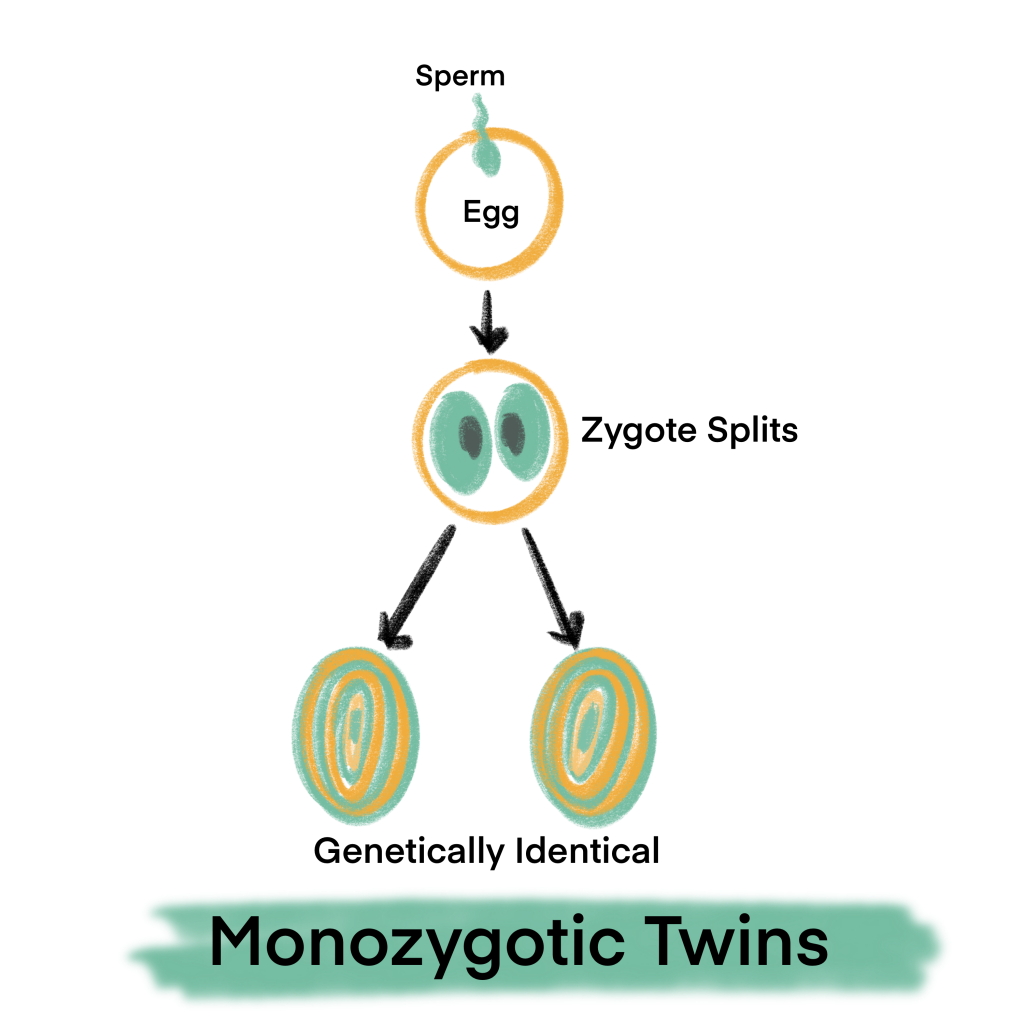What Is A Monozygotic Twin

The recent surge in the use of artificial reproductive techniques has led to an increase in multifetal pregnancies.
About 1.6 million twins are born each year. The increased rate is due to the delay in the childbearing age and increased use of in-vitro fertilization techniques.
The twins can be of three types of twins:
- Monozygotic Twins ( Identical Twins)
- Dizygotic Twins ( Fraternal Twins)
- Conjoined Twins
What Are Monozygotic Twins
The monozygotic twins are also known as Identical Twins or Uniovular Twins.
Monozygotic twins arise from the splitting of a single fertilized ovum or egg. As a result, there is sharing of genes between the twins and are always of same-sex.

Incidence
The monozygotic twins ( 20%) are not as common as Dizygotic Twins (80%).
The global incidence of Monozygotic twins is 1 in 250.
The splitting of the fertilized ovum is a random event and not influenced by the family history.
There is always a history of following features in women with monozygotic twins.
- Use of ovulation-inducing drugs like gonadotropin for fertility treatment
- Use of artificial reproductive techniques
- Elderly age during pregnancy
Disclosure:
“This post may contain affiliate links. I earn a small commission when you purchase through a link provided in this post at no additional cost charged to you. Thanks”
What Is The Cause Of Monozygotic Twins
The monozygotic twins occur when a single egg cell is fertilized by a single sperm cell.
The fertilization forms the zygote. During the early stage of development, the zygote separates into two embryos. Later the two embryos develop as twins.
Diagram

DNA Of Identical Twins
The monozygotic twins share their DNA as they were formed from the same egg and sperm.
The fetus growing inside the womb faces external influences like:
- Nutrition
- Environmental factors
- Influence from family members
The influences from the factors mentioned above will alter the genes. For example, it will make identical twins different individuals.
So the monozygotic twins may not be 100% identical in all cases.

Fingerprints Of Identical Twins
The fingerprints of identical twins are not the same. There may be some similarities in the loops and ridges pattern, but it will be an exact match.
No two people have the exact matching fingerprints. And the same rule applies to identical twins as well.
Can Identical Twins Have Separate Sacs And Placenta
The chorionicity reflects the number of placenta in pregnancy. Therefore, it is crucial to know about this number during each twin pregnancy.
During a twin pregnancy, there can be either one placenta or two. The formation of the placenta depends on the timing of the division of fertilized ovum.
Dichorionic Diamniotic
If the division occurs 72 hours after the fertilization, there will be:
- two placenta
- two amniotic sacs
Each baby here will have one placenta and one amniotic sac.
Monochorionic Dimaniotic
If the division occurs four to eight days after the fertilization, there will be:
- one placenta
- two amniotic sacs
It is the most common variant of placenta formation during twin pregnancy.
There will be one single placenta for two babies. There will be a separate amniotic sac for each baby.
Monochorionic Monoamniotic
If the division occurs after eight days of fertilization, there will be:
- one placenta
- one amniotic sac
Conjoined Twins
If the division occurs after 14 days of fertilization, it will form conjoined twins. Thus, it is a rare variant of monoamniotic twins.
The failure to separate the ovum into two individuals forms the conjoined twins. The condition is diagnosed with ultrasound imaging.

Why Is Chorionicity Important
The chorionicity of the twin pregnancy depends on the number of placenta present. There are many risks associated with a monochorionic twin pregnancy.
The risks are due to the presence of a single placenta, which increases the chances of vascular anastomoses.
Thus, it is vital to know about chorionicity during pregnancy. In addition, the obstetrics risk management and outcome depend on the chorionicity.
Ultrasound Differentiation Of Chorionicity
The chorionicity is determined by ultrasonography around 10 to 13 weeks of gestation.
During the Monochorionic Twins Ultrasonography, Findings Are As Follows:
- Single placenta
- Concordant twins mean the presence of the same trait in both twins.
- Placental membrane thickness is less than 2 mm.
- Two layers of membranes in the placenta
During the Dichorionic Twin Ultrasonography, Findings Are As Follows:
- Double placenta
- Discordant or Concordant twins
- Placental membrane thickness is more than 2 mm.
- Four layers of membranes in the placenta – two amnion and two chorion

Disclosure:
“This post may contain affiliate links. I earn a small commission when you purchase through a link provided in this post at no additional cost charged to you. Thanks”
Ultrasound Features In Monozygotic Twins
Health care professional usually performs a transvaginal scan to precisely know :
- Number of fetuses
- Placenta
- Amniotic sacs
Twin Peak Sign Or Lambda Sign:
The chorion insinuates between the layers of the intertwin membrane. As a result, it will form a characteristic triangular appearance.
Lambda sign suggests the presence of two placentae in the twin pregnancy. It is best appreciated around 10 – 14 weeks of gestation.
T Sign:
T sign is the absence of Lamba Sign during the ultrasonography examination. It is due to the chorion, which will not extend between the intertwin membrane.
T sign is characteristic of the pregnancy with a single placenta.
Complications Of Monozygotic Twins
Monochorionic Twins are a variant of monozygotic twins. There is a range of complications seen during monozygotic twin pregnancy.
The complications during the monozygotic twin pregnancy are due to the presence of one placenta.
The single placenta will create unbalanced vascular anastomoses.
The complications see during the monozygotic twin pregnancies are:
- Twin – Twin transfusion syndrome
- Conjoined twinning
- Intrauterine growth retardation
- Single fetal demise
- Acardiac fetus
Hydramnios, miscarriage, intrauterine death, and fetal anomalies like complications are seen in monozygotic twins.

Identical Twins As Individuals
We often refer to the monozygotic twins as identical twins, but they will become two different individuals later in their life.
The twins will be influenced by the factors around them and become unique individuals.
Look for the warning signs during the pregnancy period.
Consult your healthcare provider for discomfort, pain in the abdomen or lower back, etc.
.

